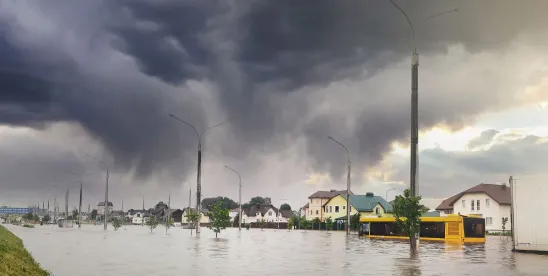Hurricane season began on June 1, and the National Oceanic and Atmospheric Administration is predicting an 85 percent chance of an above-normal hurricane season due to exceptionally warm ocean temperatures and developing La Nina conditions. Now is the time to prepare for a potentially busy hurricane season and ensure your business is properly insured.
Here are some insurance-related steps you should be taking now to ensure that your business will be in the best position should a hurricane arrive later:
- Review what your policy covers. Reviewing your specific insurance policy can help you take the necessary steps before a hurricane arrives and immediately after. In hurricane-prone areas, many commercial property insurance policies may exclude hurricane and windstorm damage, or otherwise contain a much higher-deductible, for these risks. Analyze your policy to determine whether it covers:
- Flood damage, even if caused by a storm surge or wind-driven rain.
- Physical loss or damage to insured property, including whether the policy includes replacement cost coverage (to cover costs to replace or rebuild damaged property) rather than actual cash value coverage, which covers only the depreciated value of your damaged property.
- Spoilage coverage for perishable goods – particularly important for businesses in food service or grocery.
- Debris removal.
- Business interruption and extra expense coverage including loss of income, and increased temporary operating expenses incurred while repairs are being made and extended period of indemnity coverage for costs incurred in ramping up back to normal operating levels after repairs are complete.
- Ingress and egress coverage to cover lost business income when entry or exit from the property is not possible because of property damage including blocked roads or broken bridges.
- Contingent business interruption coverage, to cover lost business income because of disruptions in supply chain caused by physical damage at other locations in your supply chain or physical damage to customers or attraction properties.
- Civil authority coverage to cover lost business income due to governmental orders, including curfews or other prohibitions.
- Damage to improvements such as signage, fencing, landscaping, and trees.
- Be mindful of the when the hurricane damage must be reported. In Florida, according to a new property insurance statute, property damage must be reported within one year of the date of the loss. Otherwise, the claim will be barred regardless of the fact that the statute of limitations for these claims is five years. Additionally, if you intend to bring a supplemental claim, notice of this additional claim must be given within 18 months of the loss. Note that the “date of loss” for hurricanes is the date that the hurricane made landfall. In Texas, damage must be reported within two years of the initial incident that caused the property damage based on the statute of limitations.
- Review your company’s disaster plan. Every disaster plan should include an insurance-related portion which should appoint a person who is tasked with communicating with the insurer, broker, and recovery vendors. Record your pre-loss inventory to assist with adjusting losses after the storm and ensure that you take photos and videos of storm damage. Establish a system for recording all storm-related costs, expenses, and losses. Maintain copies of all correspondence between your company and the insurer. Verify if your insurer requires you to submit a proof of loss, outlining the amount being claimed as storm-related loss, and what the timeframe is for when it must be submitted. Some policies require that a proof of loss be submitted relatively quickly (often within 60 days). If your insurer requires a proof of loss, ensure that the document is reviewed by coverage counsel before submitting it because it can be used to limit your recovery.
- Mitigate and document your losses. All businesses have a duty to mitigate their losses regarding property damage. Before the storm, consider boarding up locations and using sandbags to minimize damages. After the storm, consider mitigating damages by clearing debris and elevating electrical systems. Take photos before and after the storm, prior to any mitigation efforts, to avoid disputes over what damage was actually caused by the storm. Next, document these mitigation efforts because they will be used as part of the formal claims process.
- Understand causation issues surrounding storm damage. Most policies include an “anti-concurrent causation” provision that removes coverage for damage caused directly or indirectly by an excluded peril regardless of whether any other cause contributed to the loss. Courts often enforce these provisions. Insurers will attempt to prove that the loss was caused by an excluded peril in the policy, which may include flooding. However, if a covered peril and an excluded peril both contribute to a loss and the covered peril was the predominant cause, the policy will cover the loss incurred. Thus, you should consider whether experts (such as engineers, weather experts, etc.) should be retained to help you argue for coverage. Coverage counsel can assist in making this determination.






 />i
/>i

